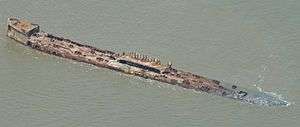SS Selma (1919)
 Selma | |
| History | |
|---|---|
| Name: | SS Selma |
| Builder: | F.F. Ley and Company, Mobile, Alabama |
| Launched: | 28 June 1919 |
| Fate: | Abandoned in 1922 |
| General characteristics | |
| Tonnage: | |
| Length: | 425 ft (129.54 m) |
| Beam: | 54 ft (16.46 m) |
| Draught: | 36 ft (10.97 m) |
| Propulsion: |
|
|
SS Selma | |
| Location | Galveston, TX |
|---|---|
| NRHP Reference # | 93001449 |
| Added to NRHP | January 5, 1994 |
Coordinates: 29°20′39″N 94°47′11″W / 29.3442°N 94.7863°W
SS Selma was an oil tanker built in 1919 by F.F. Ley and Company, Mobile, Alabama. President Woodrow Wilson approved the construction of 24 concrete vessels of which only 12 were actually completed.
SS Selma is the only permanent, and prominent, wreck along the Houston Ship Channel. It lies approximately one mile north of Galveston Island.
Construction and career
Steel shortages during World War I led the US to build experimental concrete ships, the largest of which was the SS Selma, today partially submerged in Galveston Bay and visible from both the Houston Ship Channel and Seawolf Park.
SS Selma was built in Mobile, Alabama, and named to honor Selma, Alabama, for its successful wartime liberty loan drive. The ship was launched on June 28, 1919, the same day Germany signed the Treaty of Versailles, officially ending World War I. As a result, the 7,500-ton ship never served during the war, but instead was placed into service as an oil tanker in the Gulf of Mexico.
On May 31, 1920, the Selma hit a jetty in Tampico, Mexico, ripping a 60 foot hole in her hull. After attempts to repair the ship in Galveston failed and efforts to sell the ship proved unsuccessful, US officials decided to intentionally scuttle the ship. A channel 1,500 feet long and 25 feet deep was dug to a point just off Pelican Island's eastern shoreline where on March 9, 1922, the ship was laid to rest. The wreck of the Selma has since been the object of failed plans to convert it for use as a fishing pier, pleasure resort, and an oyster farm. Long a source of curiosity and local legend, it remains important to scientists who continue to study aspects of its concrete construction.
See also
References
- Rob Bender - Concrete Ships - http://www.concreteships.org - 6/23/2011
- Texas Historical Commission - http://atlas.thc.state.tx.us/viewform.asp?atlas_num=5167011567&site_name=SS+Selma&class=5000
External links
- S.S. Selma article on CrystalBeach.com - http://www.crystalbeach.com/selma.htm
- S.S. Selma article on ConcreteShips.org - http://www.concreteships.org/ships/ww1/selma/